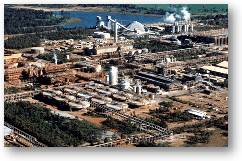Mining
Aluminium is mined by surface methods (open cut mining) which involves the removal of topsoil and overburden to expose the ore. During the extraction process the ore carrying rock, is broken by bulldozers or explosives. The bauxite is mined by heavy industrial machinery, e.g. power shovels, or hydraulic excavatorsand loaded in large trucks which can carry 50 to 100 tonne loads.
Often the bauxite is then crushed and washed to remove some of the clay and sand waste and dried in rotary kilns. The crushed bauxite is easier to transport to the alumina refinery and is the first stage of the refining process. The ore is loaded into trucks, railway cars, or conveyor belts and transported to shipsor refineries.
Processing
- Digestion - Crushed bauxite is fed into a caustic soda solution. This bauxite slurry is mixed and heated in vessels (digesters). This produces a "green liqour" containing sodium aluminate. Silica is a most undesirable impurity in must be removed by 'desilication'.
- Clarification - The coarse sand (waste containing undissolved iron oxides, silica and other trace materials) and fine mud (mostly iron oxide and fine quartz) are separated from the "green liquor" by settling and then passing it through filters.
- Precipitation - This is the chemical process in which the alumina is removed from the liquor leaving alumina hydrate crystals. The "green liquor" is cooled by passing through a heat exchanger and then through tall vessels where it is precipitated. These crystals are separated into large and small crystals. The remaining liquor is re-cycled.
- Calcination - The product is pumped from the tank as a slurry into large conical vessels called classifiers, where large and small crystals are again separated and small crystals are returned to the tanks, and the large crystals are pulled out by the classifier system. The remaining liquor is recycled in the original digesters.
Aluminium is then extracted using the Hall-Heroult smelting process. An electric current is passed through a molten solution of the alumina and cryolite (sodium aluminium fluoride) in a series of reduction cells, which are lined at the bottom with carbon (the cathode). Inserted into the top of each pot are carbon anodes, the bottoms of which are immersed in the molten solution. The electric current causes the oxygen from the alumina to combine with the carbon of the anode forming carbon dioxide gas. The molten aluminium settles at the bottom of the pot and is drawn off. Once formed, the aluminium is siphoned from the furnaces, often alloyed, and cast into various shapes
Smelting aluminium brings with it environmental impacts associated with conventional energy supply, such as emissions of carbon dioxide and sulphur dioxide. Considerable waste is also produced in the extraction and refining process, 50 tonnes for every 1 tonne of aluminium produced, and fluoride emissions and dusty or corrosive material from the refineries can also damage local ecosystems if not strictly controlled.
|

